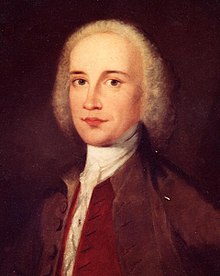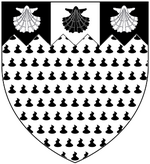John Taylor (manufacturer)
John Taylor | |
|---|---|
 Portrait by unknown artist | |
| Born | 1711 |
| Died | 1775 (aged 63–64) |
| Nationality | English |
| Occupation(s) | Manufacturer, banker, High Sheriff of Warwickshire |

John Taylor (1711–1775)[2] of Bordesley Hall near Birmingham (then a small town in Warwickshire), was an English manufacturer and banker. He served as High Sheriff of Warwickshire in 1756–57.
Origins
John Taylor was the eldest son and heir of Jonathan Taylor (died 1733) of Bordesley by his wife Rebecca Kettle.[3]
Career
Taylor became a cabinet maker in Birmingham. There he set up a factory in what is now Union Street to manufacturer "Brummagem toys", such as buttons, buckles, snuff boxes and jewellery boxes. He made a fortune selling silver-plated articles, and he used the plating process devised by Thomas Boulsover.[4] He eventually employed 500 people and became one of Birmingham's leading industrialists. The output of buttons from his works was estimated at £800 per week. Taylor invested the profits of his business in local land and property, buying Sheldon Hall in 1752 and Moseley Hall and the manor of Yardley in 1768, and eventually owned about 2,000 acres. In 1765, in partnership with his neighbour, the Quaker iron merchant Sampson Lloyd II (1699–1779) (who in 1742 purchased as his country residence the estate of "Farm" within the manor of Bordesley), Taylor founded Taylor and Lloyd's Bank in Dale End, Birmingham, which eventually grew into Lloyds Banking Group, one of the largest banks in the United Kingdom.[5]
Marriage and children
In 1734 Taylor married Mary Baker, by whom he had children[6] including John Taylor (1738–1814), his eldest surviving son, of Bordesley Park, Warwickshire and Moseley Hall, Worcestershire, who became a Justice of the Peace, Deputy Lieutenant, and High Sheriff of Warwickshire in 1786. In 1778 he married Sarah Skey, the eldest daughter of Samuel Skey of Spring Grove, Worcestershire. His 1788 portrait by Thomas Gainsborough is in the Museum of Fine Arts, Boston.[7] and a companion portrait by Gainsborough of his wife Sarah is in the National Gallery of Art in Washington. They had three sons, John (born 1780), James (1783–1852) and William (1789–1839).
Death and legacy
Taylor died in 1775 and was buried in a vault in St Philip's Parish Church, Birmingham, built in 1711 on land donated in 1710 by Robert Philip. James Watt commented that at his death Taylor was worth some £200,000. He was succeeded by his son John Taylor (1738–1814), who rebuilt Moseley Hall. Both Bordesley Hall and Moseley Hall were later burnt down by mobs during the Priestley riots of 1791 but were subsequently rebuilt.
References
- ^ Burke's Genealogical and Heraldic History of the Landed Gentry, 15th Edition, ed. Pirie-Gordon, H., London, 1937, p.2212
- ^ Date of birth 1711 per Burke's Genealogical and Heraldic History of the Landed Gentry, 15th Edition, ed. Pirie-Gordon, H., London, 1937, pp.2211-2, Pedigree of Taylor of Strensham
- ^ Burke's Genealogical and Heraldic History of the Landed Gentry, 15th Edition, ed. Pirie-Gordon, H., London, 1937, pp.2211-2, Pedigree of Taylor of Strensham
- ^ Paul H. Emden's "Quakers in commerce: A record of business achievement", pp.41
- ^ "The beginnings of Lloyd's Bank". British Banking History Society. Archived from the original on 28 April 2012. Retrieved 17 September 2013.
- ^ Burke's Genealogical and Heraldic History of the Landed Gentry, 15th Edition, ed. Pirie-Gordon, H., London, 1937, pp.2211-2, Pedigree of Taylor of Strensham
- ^ "John Taylor (1738–1814)".
- "TAYLORS". Archived from the original on 12 October 2013.


